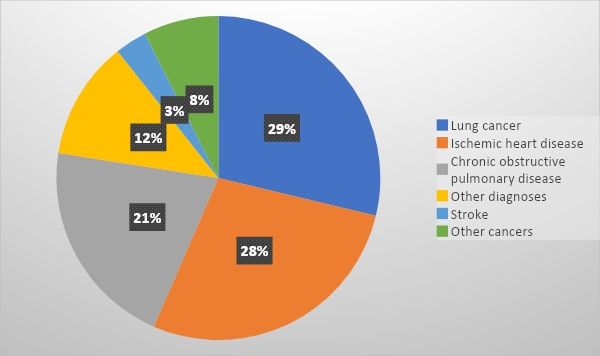Many health problems exist because of lifestyle or health habits that increase the risk of chronic disease and death. For example, people continue to use tobacco despite being known to cause cancer, bronchitis, emphysema, chronic airway obstruction, heart disease, premature birth, stillbirth, and infant death. Smokeless tobacco usages such as vaping and chewing can also cause various oral health problems like tooth loss, periodontitis, cancer of the mouth and gums, and even death. According to Hanson et al. (2018), two new young smokers replace every adult who dies prematurely because of smoking. Smoking initiation and pursuance are usually influenced by individual factors such as perception, self-image, and peer pressure. Additional factors include societal norms, promotional adverts that encourage smoking, parental example, stress, anxiety and depression, and nicotine exposure during childhood (Hanson et al., 2018). In addition, some TV shows, music videos, and digital media content portray smoking smokeless tobacco, waterpipe tobacco, cigars, and e-cigarettes as something exciting and fashionable, thus influencing a significant number of youths into smoking. However, the health dangers of smokeless tobacco use and waterpipe tobacco are often little known by users.
The tobacco epidemic is a major global public health threat that kills more than eight million people worldwide. Seven million people die because of direct tobacco use, while the rest are because of secondhand smoke exposure to non-smokers (World Health Organization [WHO], 2021). In 2014, 25.2 percent of the American population aged 12 or older reported current use of a tobacco product (Hanson et al., 2018). In 2019, the rate of tobacco usage among adults in the United States was 17.1 percent, while in California, it was 11.2 percent, targeting 9 percent by the end of 2022 (Centers for Disease Control and Prevention [CDC], 2021). The impact of nicotine addiction on morbidity, mortality, and economic costs to society is staggering. Smoking-related illness in the US costs more than $300 billion annually, including $170 billion for direct medical costs (Hanson et al., 2018). It also costs the American economy $156 billion in lost productivity. The CDC estimates that these costs could increase if the public health sector does not intervene to lower the number of tobacco users in society (Hanson et al., 2018). In California, the smoking-related costs are $13.29 billion per year.

The state of California has laid down strategies to reduce the tobacco epidemic. In 2016, the state passed multiple tobacco control laws that closed the gaps in the previous smoke-free laws. The new laws made small businesses, hotel lobbies, and break rooms smoke-free. The laws also banned vaping wherever smoking is prohibited and categorized e-cigarettes as a tobacco product. The enacted laws also raised the legal age of purchasing tobacco from 18 to 21 years, increased tobacco license fees, and made all K-12 public schools tobacco-free zones (CDC, 2021). These laws were passed to protect children and the rest of the population from secondhand smoke exposure in public places.
Despite such public health efforts, California still experiences new tobacco-related morbidity cases. These cases are attributed to ease of access to tobacco products; for example, in Panorama City, the rate of liquor stores that sell tobacco products is 12.26 per 100,000 population (US Census Bureau, 2021). However, the CDC is educating people on the dangers of smoking through an education campaign referred to as Tips From Former Smokers. The program features speakers and educators who are actual former smokers suffering from the real costs of tobacco usage (CDC, 2021). The program connects tobacco users who want to stop with resources to help them stop.
Tobacco prevention and control measures are one of public health’s primary campaigns. Tobacco control programs aim to reduce the number of tobacco users and tobacco-related diseases and mortality (Hanson et al., 2018). The control program should prevent the initiation of tobacco among teenagers and youths, help tobacco users quit, and protect the public from secondhand smoke. The program should combine multiple evidence-based approaches, including regulatory, educational, social, and economic strategies at local and statewide levels. For example, for strategies to work effectively in Panorama City, they have to be implemented by the entire state of California. Effective tobacco control strategies include taxation, tobacco price increases, comprehensive smoke-free policies, and active anti-tobacco mass media campaigns. The program’s education campaign aims to enlighten people on the dangers of smoking and eliminate tobacco-related disparities among youths. The campaign posters should include graphic images of the damaging effects of tobacco. Society should understand that waterpipe tobacco, pipes, cigarettes, and e-cigarettes are all tobacco products and are harmful. Protecting the public from secondhand smoke is achieved by enacting laws prohibiting tobacco products in public places.
Tobacco use cessation strategies should target all tobacco product usage initiation and cessation. Tobacco usage is harmful, and the strategies should aim at preventing initiations, helping existing smokers quit, and protecting the public from secondhand smoke. However, despite California’s public health sector efforts in attaining these goals, some challenges prevent them from attaining the targeted 9 percent rate of tobacco users. Examples of these challenges are the lack of nationwide commitment to impose strict tobacco regulations to lower tobacco usage and the availability and accessibility of tobacco products around the city. Therefore, there is a need for a more comprehensive review of the availability and accessibility of tobacco products nationally.
References
Centers for Disease Control and Prevention. (2021). Extinguishing the tobacco epidemic in California. Centers for Disease Control and Prevention. Web.
Hanson, G., Venturelli, P. J., & Fleckenstein, A. E. (2018). Drugs and society (13th ed.). Jones & Bartlett Learning.
United States Census Bureau. (2019). County Business Patterns. Web.
World Health Organization. (2021). Tobacco [Fact sheet]. World Health Organization. Web.
